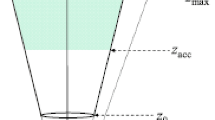Abstract
The distinctions between compact cores in various powerful extragalactic sources have proved difficult to interpret. In a few source categories (for example radio galaxies and quasistellar radio sources) extended structure on much larger scales exist; their energy is undoubtedly supplied through the narrow channels that are being increasingly observed and seem to be directed from the compact cores. Continuous production of high-energy plasma in a high-pressure region at the core centre is necessary to account for the energetics and channel structures1. The twin-exhaust mechanism2 is one means of forming double jets in active galactic nuclei. As originally envisaged2 , the ‘central engine’ continuously releases hot gas in the centre of a flat-bottomed potential well formed by the stellar cluster in a galactic centre. This potential well holds a cloud of cooler gas which confines the hot gas in a central cavity. If the cooler gas cloud is flattened (for example, by rotation), buoyancy forces can accelerate the hot gas into two collimated jets via de Laval nozzles. These jets may correspond to the observed radio jets in quasars and radio galaxies, and result in the formation of extended double sources. Here, we combine new results from numerical calculations5 of the Blandford–Rees model2, with severe observational and theoretical constraints, to reach conclusions concerning the nature of the allowed flows. In particular, we conclude that high-velocity, high-powered jets cannot be produced in gravitational potentials produced by stellar clusters. However, the more general notion of the twin-exhaust mechanism1, in which the central potential can be cusp-like near a massive black hole, is not ruled out for the high-powered radio sources. Note also that more compex twin-exhaust models (for example, magnetohydrodynamic flows) may lead to less severe constraints.
Similar content being viewed by others
References
Rees, M. J. IAU Symp. 94 (1980).
Blandford, R. D. & Rees, M. J. Mon. Not. R. astr. Soc. 169, 395 (1974).
Wiita, P. J. Astrophys. J. 221, 41 (1978).
Wiita, P. J. Astrophys. J. 221, 436 (1978).
Norman, M. L., Smarr, L., Wilson, J. R. & Smith, M. D. Astrophys. J. (in the press).
Smith, M. D., Smarr, L., Norman, M. L. & Wilson, J. R. Astrophys. J. (in the press).
Miley, G. K. A. Rev. Astr. Astrophys. 18, 165 (1980).
Potash, R. I. & Wardle, J. F. C. Astrophys. J. 239, 42 (1980).
Burbidge, G. Proc. IAU Symp. 44 (1974).
Tananbaum, H. et al. Astrophys. J. 234, 9 (1979).
Ku, W.H.-M., Helfand, D. J. & Lucy, L. B. Nature 288, 323 (1980).
Begelman, M. C. & Rees, M. J. Mon. Not. R. astr. Soc. 185, 847 (1978).
Spitzer, L. & Saslaw, W. C. Astrophys. J. 143, 400 (1966).
Blandford, R. D. & Icke, V. Mon. Not. R. astr. Soc. 185, 527 (1978).
Perley, R. A., Willis, A. G. & Scott, J. S. Nature 281, 437 (1979).
Young, P. J., Sargent, W. L. W., Kristian, J. & Westphal, J. A. Astrophys. J. 234, 76 (1979).
van Groningen, E., Milley, G. K. & Norman, C. A. Astr. Astrophys. 90, L7 (1980).
Author information
Authors and Affiliations
Rights and permissions
About this article
Cite this article
Smith, M., Smarr, L., Norman, M. et al. Can the twin-exhaust model explain radio jets?. Nature 293, 277–279 (1981). https://doi.org/10.1038/293277a0
Received:
Accepted:
Issue Date:
DOI: https://doi.org/10.1038/293277a0
- Springer Nature Limited





